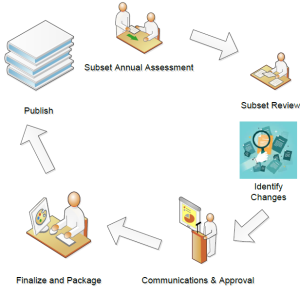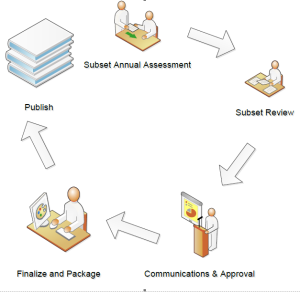What is Subsets?
A subset is a set of members all of which are members of another set (from set theory in mathematics), but generally, in clinical terminologies, it is a set of concepts or terms taken from a larger set of terms or concepts.
The purpose of using subsets is to facilitate the adoption or implementation of health terminologies. Clinical terminologies often contain thousands if not hundreds of thousands of terms. While SNOMED CT content has approximately a million concepts, LOINC contains nearly 97,000 terms. The use of subsets can help narrow down the content in terminology that is relevant for a specific use case. Subsets can contain just a few terms or may contain thousands of terms, depending on the purpose of the subsets.
At the time subsets are published they are created against the most current version of the standard. Canada Health Infoway maintains these subsets in partnership with Provincial, Territorial, and Federal e-Health agencies from across Canada working towards the successful implementation of Digital Health solutions.
Infoway plays an important role in reviewing and hosting subsets on the Terminology Gateway for jurisdictions and organizations to utilize.
In general, the goals of subset creation are twofold:
• Enables clinicians to report procedures and services by making it possible for them to select from a group of content most relevant to other specialties or services.
• Support the exchange of the information between Clinicians and institutions in a consistent manner
Types of Subsets
Subsets can be grouped into categories. The categories listed below are different ways of looking at subsets and are not mutually exclusive:
- Data capture vs Data retrieval subsets:
Subsets may be used for data capture (eg, used by a physician at the point of care in an EMR to record a procedure or service provided) or for data retrieval (eg, used by a physician for retrieving information about patients who have received a specific set of procedures or services). In some cases, the content in these types of subsets may differ.
- Physician specialty vs Electronic health system-specific field subset
Subsets may be developed for physician specialties or sub-specialties (eg, cardiology or interventional cardiology) or for a more general use case (eg, immunizations, Evaluation and Management). For example, the cardiology physician specialty subset should include all procedures and services a cardiologist may conduct or perform, while an immunizations subset should contain a list of all immunization procedures and will not be limited to one physician specialty; it may be used by a general practitioner or a pediatrician to record immunizations done.
- Intensional vs Extensional subsets SNOMED CT Example
Subsets can be developed intensionally or extensionally. The term “extensional subsets” refers to explicitly enumerating each and every code and/or Clinician Descriptor. On the other hand, the term “intensional subsets” refers to specifying the sections/hierarchies and/or subheadings that contain content that is to be included in a subset.
- Concept/Code Subsets vs Clinician Descriptions Subsets
Subsets can be developed at the code/term level or at the Clinician Descriptors level.
Clinician Descriptor's (CDs) purpose is to clearly and specifically describe precisely the procedure or service performed by a physician/doctor or qualified healthcare professional at the point of care. Clinician Descriptors will also reflect the granularity necessary to describe clinically relevant information. As a result, many existing codes will be mapped to more than one CD. These CDs will be easily understandable to the physicians/doctors or other qualified healthcare professionals who have little or no knowledge of coding and are primarily concerned with the clinical representation of the data rather than other aspects of the data e.g. the administrative or claim reimbursement.
Clinician Descriptors are more specific services or procedures that are included in the catalogues such as the Ontario Schedule of Benefits .
These subsets types can be created by many methods, but here are a few commonly used:
- Manual inclusion, using search and browse methods
- An existing subset, used as a starting point for further manual inclusion and update
- Lexical queries, to identify candidate members, followed by manual verification and update
- Hierarchical queries, to identify descendants of a given concept (e.g. descendants of <73211009 |diabetes mellitus|)
- Attribute queries, to identify concepts with a specific attribute value (e.g. disorders with a finding site of 80891009 |heart structure|
- SNOMED CT queries, using the SNOMED CT Expression Constraint or Query languages, which offer additional query functionality.
Subsets Maintenance
pan-Canadian Subset Maintenance
Infoway has many subsets that have been developed over time by Canadians for Canadians. These “fit for use” subsets are intended to be a pan-Canadian “starter set” of content. The subsets are maintained by Infoway, published in the Terminology Gateway. The pan-Canadian Subsets may contain content from international terminologies and content specific to Canada, which is dependent on the international version. The pan-Canadian subsets are reviewed on an annual basis, SNOMED CT subsets updated are aligned to the release of SNOMED CT Canadian edition releases.
Two subsets HealthCareProviderRoleType and QualifiedRoleType use the SC code systems (SCPQUAL, SCPTYPE) (the "SC Code Systems") which was a code system developed by Canada Health Infoway Inc. (Infoway) to address local requirements in Canada. SC was an abbreviation for "Standards Collaborative"
Additional Terminology Subsets
Infoway supports organizations and Jurisdictions to publish their Terminology Artefacts on the Terminology Gateway. Once published, jurisdictions are requested to maintain their subsets as part of the Infoway Maintenance Cycle.
These subsets may be leveraged by other organizations and jurisdictions to support interoperability EHR solutions in their organization or jurisdiction.
The subsets developed are vendor-neutral, they support interoperability and decrease the cost of creating and maintaining a new subset.
Naming Convention for pan-Canadian Reference Sets and ValueSets
Please refer to the Naming convention for pan-Canadian Reference sets and Value sets.pdf document for detailed rules for consistent naming of pan-Canadian reference sets and value sets.

